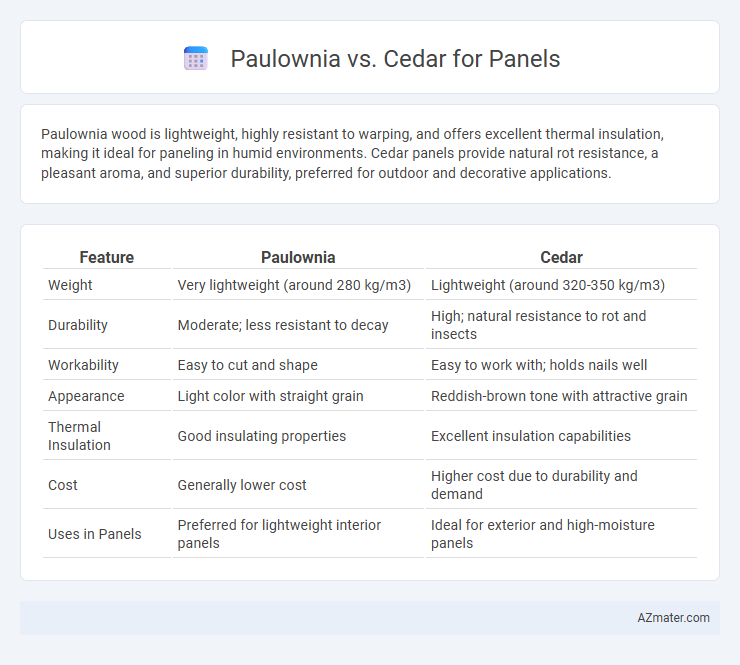Paulownia wood is lightweight, highly resistant to warping, and offers excellent thermal insulation, making it ideal for paneling in humid environments. Cedar panels provide natural rot resistance, a pleasant aroma, and superior durability, preferred for outdoor and decorative applications.
Table of Comparison
| Feature | Paulownia | Cedar |
|---|---|---|
| Weight | Very lightweight (around 280 kg/m3) | Lightweight (around 320-350 kg/m3) |
| Durability | Moderate; less resistant to decay | High; natural resistance to rot and insects |
| Workability | Easy to cut and shape | Easy to work with; holds nails well |
| Appearance | Light color with straight grain | Reddish-brown tone with attractive grain |
| Thermal Insulation | Good insulating properties | Excellent insulation capabilities |
| Cost | Generally lower cost | Higher cost due to durability and demand |
| Uses in Panels | Preferred for lightweight interior panels | Ideal for exterior and high-moisture panels |
Introduction to Paulownia and Cedar Wood Panels
Paulownia wood panels are lightweight, durable, and resistant to warping, making them ideal for furniture and interior applications, while offering a smooth, fine grain for easy finishing. Cedar wood panels provide natural insect resistance and a distinctive aromatic scent, along with excellent stability and decay resistance, favored in outdoor and decorative uses. Both woods present unique advantages in panel production, with Paulownia excelling in weight-to-strength ratio and Cedar in longevity and natural preservation.
Botanical Overview: Paulownia vs Cedar
Paulownia (Paulownia tomentosa) is a fast-growing hardwood tree native to East Asia, renowned for its large leaves and lightweight, yet strong timber, often used in panel applications for its stability and resistance to warping. Cedar, primarily from the genus Cedrus or related species like Western Red Cedar (Thuja plicata), is valued for its aromatic, reddish wood that offers natural decay resistance and insect repellency, making it a preferred choice for outdoor panels. Both species differ significantly in growth rate, density, and resin content, influencing their suitability for various paneling applications depending on durability and aesthetic requirements.
Physical Properties Comparison
Paulownia wood is significantly lighter than Cedar, with a density around 260 kg/m3 compared to Cedar's typical 370 kg/m3, making Paulownia ideal for lightweight panel applications. In terms of hardness, Cedar scores higher on the Janka scale, approximately 350 lbf, whereas Paulownia registers around 200 lbf, indicating greater durability and resistance to dents for Cedar. Cedar exhibits superior natural resistance to decay and insect damage due to its resin content, while Paulownia is more prone to surface scratching but offers excellent dimensional stability and low shrinkage rates.
Weight and Workability
Paulownia wood is significantly lighter than cedar, with a density of around 260 kg/m3 compared to cedar's 370 kg/m3, making it easier to handle and ideal for lightweight panel applications. Paulownia's soft texture and fine grain offer excellent workability, allowing for smooth cutting, shaping, and sanding without much effort. Cedar, while slightly heavier, provides good workability as well but is denser and more resistant, making it better suited for panels requiring durability and strength.
Durability and Resistance to Decay
Paulownia wood exhibits moderate durability with good resistance to decay, making it suitable for indoor paneling but less ideal for environments with high moisture exposure. Cedar is highly durable and naturally resistant to decay, insects, and moisture, which makes it a preferred choice for both interior and exterior panel applications. For long-lasting panels in humid or outdoor settings, cedar outperforms Paulownia in maintaining structural integrity and appearance over time.
Insulation and Acoustic Performance
Paulownia wood offers superior thermal insulation due to its low density and high porosity, making it an excellent choice for paneling that enhances energy efficiency. Cedar provides notable acoustic performance by naturally dampening sound waves, which reduces noise levels in interior spaces. Both woods deliver distinct benefits: Paulownia excels in insulation, while Cedar is preferred for sound absorption in panel applications.
Environmental Sustainability and Growth Rate
Paulownia wood outperforms cedar in environmental sustainability due to its rapid growth rate, reaching maturity in 7 to 10 years compared to cedar's 30 to 50 years, enabling faster carbon sequestration and renewable resource availability. Paulownia's lightweight and broad leaves also enhance soil health by reducing erosion and increasing organic matter, while cedar's slower growth leads to longer forest regeneration periods and potential habitat disruption. Choosing paulownia for panel production supports sustainable forestry practices and reduces environmental impact through efficient land use and faster biomass replenishment.
Cost Differences: Paulownia vs Cedar Panels
Paulownia panels are significantly more affordable than cedar panels due to the faster growth rate and lower harvesting costs of paulownia trees. Cedar panels, known for their durability and natural resistance to decay, generally come at a higher price point reflecting their longer growth cycle and higher demand in premium applications. Choosing paulownia panels offers cost efficiency for large-scale projects, while cedar remains preferred for projects valuing aesthetic and longevity despite the increased expense.
Aesthetic Appeal: Grain, Color, and Finish
Paulownia panels feature a light, creamy color with subtle, straight grain patterns that provide a clean, contemporary look ideal for modern interiors. Cedar panels showcase rich reddish-brown hues with distinctive, aromatic grain textures, creating a warm, traditional aesthetic. Both woods accept finishes well, but Paulownia's smooth surface enhances paint and veneer applications, while Cedar's natural oils highlight stains and varnishes, preserving its rustic charm.
Best Uses and Applications for Each Wood
Paulownia is lightweight and resistant to warping, making it ideal for decorative panels, furniture, and interior wall cladding where easy handling and aesthetic appeal are priorities. Cedar's natural oils provide excellent resistance to moisture and insects, making it the preferred choice for exterior paneling, siding, and outdoor furniture with long-term durability. Both woods offer unique advantages, with Paulownia suited for indoor applications requiring smooth finishes, while Cedar excels in outdoor environments due to its weather-resistant properties.

Infographic: Paulownia vs Cedar for Panel
 azmater.com
azmater.com